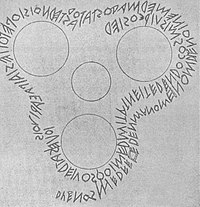
Back لاتينية قديمة Arabic Qədim Latın dili Azerbaijani Llatí arcaic Catalan Altlatein German Latinkiyo Kıhan DIQ Old Latin English Malnova Latino Esperanto Latín arcaico Spanish لاتین باستان Persian Varhaislatina Finnish
| Old Latin | |
|---|---|
| Priscan Latin | |
 The Duenos inscription, one of the earliest Old Latin texts | |
| Native to | Latium, later the Roman Kingdom and Republic |
| Region | Italy |
| Ethnicity | Latins, Romans |
| Era | Attested since 7th century BC. Developed into Vulgar Latin as colloquial form, and Classical Latin as literary form, around 75 BC. |
Indo-European
| |
Early forms | |
| Old Italic script before it evolved into the Latin alphabet | |
| Official status | |
Official language in | Rome |
| Regulated by | Schools of grammar and rhetoric |
| Language codes | |
| ISO 639-3 | None (mis) |
qbb | |
| Glottolog | oldl1238 |
 Expansion of the Roman Republic during the 2nd century BC. Very little Latin is likely to have been spoken beyond the green area, and other languages were spoken even within it. | |
Old Latin, also known as Early, Archaic or Priscan Latin (Classical Latin: prīsca Latīnitās, lit. 'ancient Latinity'), was the Latin language in the period roughly before 75 BC, i.e. before the age of Classical Latin.[1] It descends from a common Proto-Italic language; Latino-Faliscan is likely a separate branch from Osco-Umbrian with possible further relation to other Italic languages and to Celtic; e.g. the Italo-Celtic hypothesis.
The use of "old", "early" and "archaic" has been standard in publications of Old Latin writings since at least the 18th century. The definition is not arbitrary, but the terms refer to spelling conventions and word forms not generally found in works written under the Roman Empire. This article presents some of the major differences.
- ↑ "Archaic Latin". The American Heritage Dictionary of the English Language: Fourth Edition.